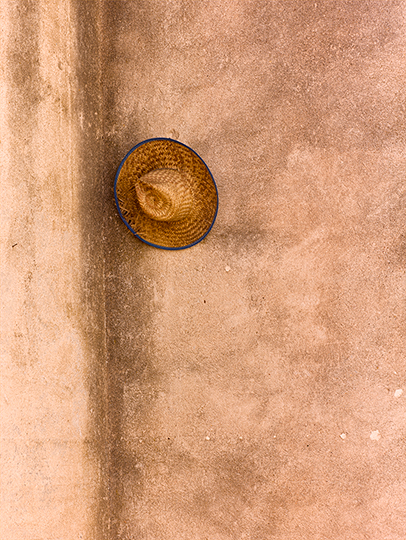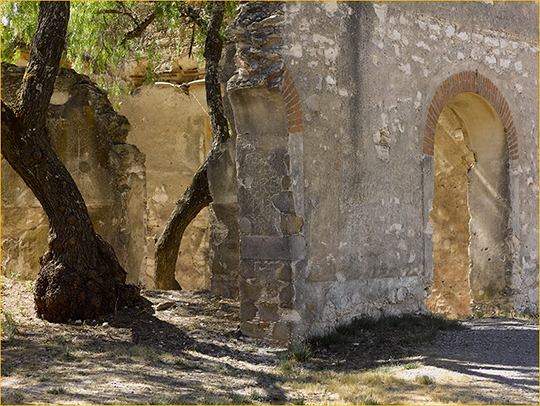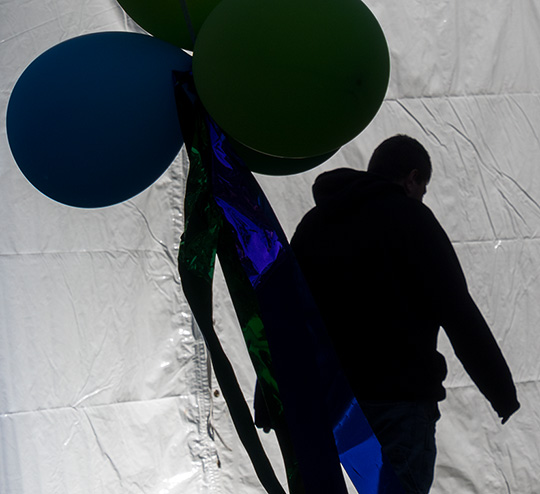
The Leaf Aptus II 12is the world’s first 80 Megapixel back. Introduced at Photokina in September, 2010 the backs are now being delivered to customers, with dealers having received their samples at the end of December.
In late January Leaf’s Product ManagerYair Saharflew from the U.K. to Mexico, where I live during the winter, so that we could spend a few days shooting together and so that I could test the new 80 Megapixel Aptus II 12.
Sidebar: By coincidence as much as anything else Yair’s visit coincided to the day with Phase One’s announcement of their newIQ180back. Indeed Phase One’s VP, Kevin Raber, flew down with a pre-production IQ180, and he and Yair overlapped visits for a day, so we had a chance to shoot with both cameras together and compare notes.
I have publisheda video interviewwith Yair and Kevin about the two company’s new competitive 80MB backs and where they fit in the marketplace.
Mexican Hat. Mineral de Pozos, Mexico. January, 2011
Phase One DF camera with 150mm lens and Leaf Aptus II 12 @ ISO 50
A Brief History Lesson
The past two years have been busy ones in the medium format industry. The global recession has certainly taken its toll. There are no exact numbers, but it’s likely that sales volume has been reduced by some 50% over what they were in 2007.
We have seen the demise of the wonderful but short livedSinar Hy6 and Leaf Aficamera, the taking of a controlling interest in MamiyabyPhase One, and also the acquisition ofLeafby Phase One. This leaves onlyHasselbladas a competitor to the Phase One conglomerate of companies in the removable back marketplace.
Of course there have also been two newcomers –Leicawith theS2andPentaxwith the645D, both very significant entrants to the MF world in their own market segment. The Leica offering has been selling very well, I’m told, with the company hardly able to keep up with demand. The delay in producing leaf shutter lenses has been an issue, but that is apparently now behind them.
The Pentax 645D has been an unexpected success story. On again and off again for years, the camera was finally brought to market last fall. The story in the industry is that Hoya wanted to sell the Pentax division, and invested in bringing the 645D camera to fruition to make the company more attractive to an buyer. But then the camera took off like a rocket. Now Pentax’s problem is that users are finding the old lens line inadequate with the new high resolution sensor, and they’re going to have to produce some strong new lenses to give the 645D legs. Fascinating.
One other bit of history worth knowing (very recent in this case) is that the long standing legal battle in the European courts between Hasselblad and Phase One is now over. Phase One won the case. What this means is that Phase One (and Leaf) can now once again make backs that work on Hasselblad H1 and H2 series backs, without restriction or royalties.
As mentioned by Yair inmy video interviewLeaf is now making their new Aptus II 12 in Hasselblad H mount. And, just a couple of days after the interview as first placed on line I learned that Phase One’ will be releasing their IQ backs in H1 and H2 mount as well once they start shipping.
Silver Mine Ruins and Tree. Mineral de Pozos, Mexico. January, 2011
Phase One DF camera with 150mm lens and Leaf Aptus II 12 @ ISO 50
Aptus Review
I had last looked at a Leaf back in mid-2006, when I had spent a few days working with Yair and theAptus 75in British Columbia. The Aptus line of backs has not changed much since then, though it had a physical screen upgrade last year, and will have a screen interface upgrade in Q2, 2011.
Just about everything that I wrote about the Aptus 75 then (excepting sensor size and image quality) holds true for the Aptus II 12 today. If you are unfamiliar with the basics of the current Aptus back design you should readthat reviewbefore proceeding.
Compared to a Phase One P series back the Aptus’ screen is a joy to use. In anything except the brightest daylight the screen is quite visible. It is a touch screen and usable with ones finger or the built-in stylus. But, it has to be said that it’s essentially a six year old design, and there has been a lot of advancement in screen technology over the past few years, especially in terms of resolution, brightness and touch sensitivity. Having said that, the screen and interface are much more pleasurable to use than a Phase P series back.
Again, compared to a Phase One P series backs the Aptus is slower to boot up, but seems to be able to shoot more frames more rapidly, through I have to admit not having done a recent timing test between them.
The battery on the Aptus fits underneath the back’s body, covering the Firewire connector. This means that the back must be powered from the Firewire connection, which can be problematic with some newer Mac portables. A Firewire “repeater” is therefore recommended by Leaf for tethered shooting.
On the other hand, because unlike a Phase P back the battery is not partially enclosed by the back itself larger high capacity batteries can be used, a real bonus on a long location shoot.
Since the Aptus backs are such a known quantity in the MF marketplace, there’s not much point in rehashing the backs operational pros and cons. I think what people really want to know is how the Aptus II 12 performs. Is 80 MP worthwhile? Can one see the difference between a 60MP and an 80MP back? What, if anything, suffers when going to 80MP? I was really curious to find out.
Aptus II 12 in The Field
Balloon Seller. San Miguel de Allende, Mexico. January, 2011
Phase One DF camera with 150mm lens and Leaf Aptus II 12 @ ISO 100
(Not critically sharp – 1/125 sec hand held)
Hand-Held Folly
Yair and I spent our first day together with me becoming refamilarized with the operation of the back, walking around San Miguel doing some hand-held shooting, and then doing some resolution tests in the late afternoon from my roof terrace.
The first thing I saw when loading the files into Capture One 6.1 was a confirmation in spades of what I had learned when first working with my Phase One P65+. These high resolution backs are unforgiving of anything less that perfect shooting technique. A hand-held shutter speed that would be fine with a DSLR or even a 30ish Megapixel back just doesn’t deliver with sensors of ultra-high resolution.
It is folly to shoot hand-held at anything less than 2X the reciprocal of the focal length, and frankly I’d shoot at 3X to be sure of getting decent quality. So, an 80mm lens needs at least a shutter speed of 1/250 sec (80X3). Even then you’ll be better of shooting from a tripod, or with electronic flash in the studio if you’re working hand-held.
Image Quality
The incremental step from 60 MP to 80MP is comparable to that from 40MP to 60MP. It’s noticeable even in moderate sized prints (though certainly not on the web) but not earth shattering. Going from 40MP to 60MP only made sense if you were really after the extra bit of resolution for making really large prints.
Going from 60MP to 80MP should represent a similar increment, but somehow it doesn’t. It seems to be more! I can’t back this up with any concrete examples (especially on the web), as the differences are subtile. But to my eye they are real. And if you’re coming from a 40MP or so back to an 80MP Aptus, you’ll simply be amazed at the increased resolution.
It should go without saying that if you’re step up from a 24MP or smaller DSLR you’ll be stepping into the bizzaro universe, where resolving tiny flecks of mascara on a model’s eyelashes from 20 feet away becomes commonplace, and being able to clearly see telephone wires at a distance of 2 miles always amazes.
DR and Noise
I’m not in a position to measure or even evaluate DR and noise characteristics. Firstly, because I am away from my office in Toronto for 4 months I don’t have access to my P65+ or files for making comparisons, and in any event I’m an empirical reviewer, not a lab tester.
With that said, to my eye the Aptus II 12 appears to offer very similar noise and DR characteristics to other current MF backs from Leaf and from Phase One. In other words, DR appears to be state-of-the-art.
As for noise, it’s a similar story to other high-res backs. ISO 50 is essentially noise free, even down to the deepest shadows. The only time I see any noise at ISO 50 or 100 is when I use Capture One 6’s High Dynamic Range Shadow Control to open up deep quarter tone areas. And even then any noise visible is only on-screen at 100%. In prints it’s invisible.
Noise starts to appear at ISO 200 and is moderately visible at ISO 400. But then, these are not devices for hand-held available light work. They are intended for use in the studio, with flash, on a tripod and when one is seeking ultimate image quality, which means using ISO 50 or 100 isn’t an issue.
Today’s CMOS equipped DSLRs are champs when it comes to low noise at high ISOs and photographers simply should not be looking at medium format backs using CCDs to compete in this area.
SensorFlex
You can set the back (or the software when tethered) to shoot a square, 60MP file. This is a WYSWYG function, so for example in Live View you will see a square preview. The file gets cropped on the fly thus speeding up both capture and processing. This feature was first introduced in Leaf’s 56MP backs a couple of years ago, and allows choosing between a full 3:2, 4:3 or 1:1 aspect ratios.
A New Touch Screen UI
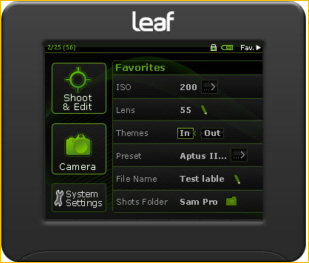
Leaf is in the process of updating the Aptus back’s user interface. Here are a couple of beta screen shots, and while I had an opportunity to play with the new interface it is still a while away from release.
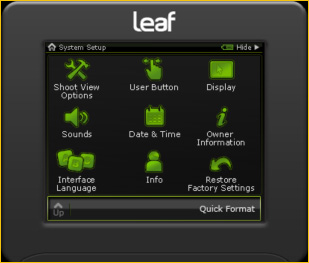
File Handling
The backs ship with Leaf Capture 11.4, and also withCapture One 6.1 which offers full tethered support including Live View and 645DF camera controls. Since I am unfamiliar with Leaf Capture my work has been with C1.
I hadn’t had a chance to work with Version 6 since it came out, but I have to say that V6 is much enhanced over V5. (I did a Capture One V5 videotutoriallast year with Walter Borchenko, which you can find out more abouthere.)
Regular readers know that I am a big fan of Lightroom, but with V6, Capture One has to my mind closed most if not all of the gap between them in terms of features. Local adjustments with layers, perspective control and more make it a real powerhouse. And of course when it comes to image quality C1 is second to no other program.
It’s still a resource hog, and you’ll need a powerful machine to make it fly, but then you’re going to need a speed demon to work with the Aptus’ 480MB files.(That’s when converted to TIF. In raw, out of the camera, they are a mere +/- 80MB).
Red Shadows
The only anomaly that I’ve noted in terms of image quality with the Aptus II 12 is a tendency toward a reddish tinge in deep shadows. This appears to be there as well in the pre-production Phase One IQ180.
I imagine that both companies will sort this out soon enough, but in the meantime with Aptus files I’ve created a Custom Style with the red channel Curve lowered slightly in the quarter tones, which seems to clean things up nicely.
The Camera Conundrum
Leaf sells their Aptus backs, including the new 80 Megapixel II 12, in mounts for virtually every camera on the market, including discontinued brands and models. With the demise of the AFi system Leaf now sells their backs with optional Mamiya branded or Phase One branded (depending on the market) DF bodies. Lenses are also branded Phase One, including the new and excellent Schneider leaf shutter lenses.
I don’t think that I’m alone in the opinion that these updated Mamiya bodies, while much better than before Phase One helped redesign them, are still not the bodies that we would like them to be. They are a legacy design and getting a bit long in the tooth.
We know that Phase One / Mamiya are developing a new body, but since a brand new camera design can take 4-6 years, and Phase has only been in control of Mamiya for less than two years, a new body is likely still some way off.
I have no such hesitations regarding Phase / Mamiya lenses. These were always pretty highly regarded, and the new redesigned digital versions are for the most part as good as anything on the market. As mentioned, the Schneider leaf shutter lenses (and there are more coming soon) have been especially well received.
Then Along Came the IQ180
Of course no product exists in a vacuum. No sooner did Leaf start shipping their Aptus II 12 in quantity than its parent company, Phase One, announced the IQ180 which uses a similar Dalsa-sourced 80 Megapixel sensor chip (the IQ180 has Sensor+ though). The IQ backs are a dramatic improvement over the previous P+ series Phase One backs, and will start to ship in late April, 2011.
So – if the IQ180 is a much more advanced and full featured design than that of the now essentially six year old Aptus II 12 (sensor excepted), why should one consider Leaf’s offering? The answer is summarized in one word – U.S. $12,000. That’s the difference in price between the two backs. Also, the Aptus II 12 is available now, while the IQ180 will not be available in quantity till May.
My feeling is that if one is looking for the highest resolution medium format back available, at the best possible price, then the Aptus is the hands-down choice. If money is a secondary factor to features and convenience, then come May the IQ180 may be your preferred choice.
As for image quality difference between the two, after a few days of side-by-side comparative testing I’d simply say that there are more similarities between the two backs than differences. Each company has their own “secret sauce” when it comes to image handling, but my impression is that only gear-head nit-pickers are going to sweat the differences in real-world shooting situations.
Simply put, the Leaf Aptus II 12 is today’s highest resolution back on the market, and it is available in mounts for virtually every medium format system ever made. It will be eclipsed in terms of bells and whistles by the IQ180 when it starts shipping this summer, but at a saving of some $12,000 over the 80MP Phase back it offers a real choice for photographers looking for ultimate image quality.
The Aptus II 12R
The back is also available in a quite unique model, designated with an “R”. The R version features an internally rotating sensor and is available on Hasselblad V and AFi / Hy6 mounts. Advantages include:
– Protecting the sensor: there is no need to remove the back when using it on a technical camera, a Hassy V series, or on the AFi/ Hy6 platform, thus reducing the risk of damage or dust on the IR filter.
– When using it on a tech camera or on a Hassy V-series, all the menus and previews remain “straight” and also any sync/ control cables stay in one place with less chance of getting in the way.
– The AFi/ Hy6 mount also offers a tilting screen, which is useful on a tech cam or with a waist level finder. It also maintains the advanced integration with the camera body (power management, single power source, remote camera control etc.)
I had never seen an Aptus R before and I was very impressed. Especially when used on a technical camera it obviates the need to remove the back, which is a real time saver, and potentially better for the health of the sensor. I asked Yair about the mechanical reliability of the rotation mechanism and his reply was that he didn’t think that Leaf had ever had a complaint about alignment issues, so I suppose it’s robust.
If you’re considering an Aptus back in one of the mounts in which the R is available, I’d strongly recommend it, as there is no premium in price for ordering it over a non-R back.
Availability
TheAptus II 12is currently shipping in Mamiya/ Phase One mounts and the Hasselblad V-mount (Aptus-II 12R). Hasselblad H mount versions have just started shipping (late January) and both Contax and AFi/ Hy6 backs will follow during the 1st or 2nd week of February. Apparently these backs are selling extremely well, with “several hundred” having been shipped in the first couple of months.
The US list price for the back is approximately $32,000. Check with your local VAR or dealer for pricing and various trade-in / trade-up offers.
January, 2011
You May Also Enjoy...
VJ0 8MP Play
Subscribe to The Video Journal Please use your browser'sBACKbutton to return to the page that brought you here.
